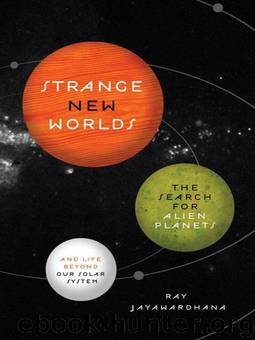Strange New Worlds by Ray Jayawardhana

Author:Ray Jayawardhana
Language: eng
Format: mobi, epub
Tags: Science
ISBN: 9781400838134
Publisher: PRINCETON UNIV PR
Published: 2011-02-15T04:23:01+00:00
All of that changed in 1995, not only for Basri but for the entire feld, as a result of multiple discoveries made almost simultaneously. John Stauffer, then at the Harvard-Smithsonian Center for Astrophysics, found a faint Pleiades member, dubbed PPl 15 (for ffteenth candidate in the Palomar Pleiades survey), which he passed on to Basri and his colleagues for confrmation. In a Keck spectrum, Basri’s team identifed the signature of lithium, proof that PPl 15 is indeed a brown dwarf. Meanwhile, in a deep survey of the 120-million-year-old Pleiades star cluster, perhaps better known as the Seven Sisters, Rebolo’s group in the Canary Islands found an object so faint and so cool compared with its stellar neighbors that it had to be a brown dwarf. They called it Teide 1, after a Spanish observatory, and inferred a mass just under sixty times Jupiter’s. Later the Canary Islands researchers teamed up with Basri to confrm the presence of lithium in Teide 1 and in a third candidate dubbed Calar 3, after another Spanish observatory.
A search targeting nearby low-mass stars also struck gold at the same time. Astronomers from Caltech and Johns Hopkins University were using the Palomar 1.5-meter telescope in southern California, equipped with a coronagraph that blocked most of a star’s light, allowing them to detect faint companions nearby. They had observed several brown dwarf candidates in 1993 and took a second set of images a year later. If a candidate is a true companion gravitationally bound to the star, the two should move across the sky in tandem, as measured against the background of much more distant stars. One of the confrmed companions was a thousand times fainter than its primary Gliese 229, which itself is a low-mass star, thus almost certainly substellar. But the team kept their fnding under wraps until they had an infrared spectrum of it in hand.
Finally they announced the discovery at the Ninth Cambridge Workshop on Cool Stars, Stellar Systems and the Sun held in Florence, Italy, in October 1995— the same event at which Michel Mayor from Geneva Observatory reported the frst extrasolar planet around 51 Pegasi. Their paper in Nature, led by Tadashi Naka-jima, Benjamin Oppenheimer, and Shrinivas Kulkarni, came out the following month. The substellar nature of Gliese 299B, as the companion was designated, was indisputable not only because it was so faint, implying a mass only thirty to forty times that of Jupiter, but also because its spectrum contained the telltale absorption features of methane. The methane molecule is common in the atmosphere of giant planets but does not form in stars, because they are too hot. Most astronomers consider Gliese 299B to be the frst defnitive brown dwarf discovered, in part because it was the coolest and least massive of the initial crop. At an age of a few billion years, its surface temperature is about 630 degrees Celsius, much cooler than the least luminous stars (at 1500 degrees Celsius). The Pleiades objects, on the other hand, are a
Download
This site does not store any files on its server. We only index and link to content provided by other sites. Please contact the content providers to delete copyright contents if any and email us, we'll remove relevant links or contents immediately.
| Anatomy | Animals |
| Bacteriology | Biochemistry |
| Bioelectricity | Bioinformatics |
| Biology | Biophysics |
| Biotechnology | Botany |
| Ecology | Genetics |
| Paleontology | Plants |
| Taxonomic Classification | Zoology |
Sapiens: A Brief History of Humankind by Yuval Noah Harari(13137)
The Tidewater Tales by John Barth(12052)
Do No Harm Stories of Life, Death and Brain Surgery by Henry Marsh(6357)
Mastermind: How to Think Like Sherlock Holmes by Maria Konnikova(6286)
The Thirst by Nesbo Jo(5827)
Why We Sleep: Unlocking the Power of Sleep and Dreams by Matthew Walker(5689)
Sapiens by Yuval Noah Harari(4591)
Life 3.0: Being Human in the Age of Artificial Intelligence by Tegmark Max(4549)
The Longevity Diet by Valter Longo(4473)
The Rules Do Not Apply by Ariel Levy(3944)
The Body: A Guide for Occupants by Bill Bryson(3869)
The Immortal Life of Henrietta Lacks by Rebecca Skloot(3850)
Why We Sleep by Matthew Walker(3807)
Animal Frequency by Melissa Alvarez(3777)
Yoga Anatomy by Kaminoff Leslie(3731)
Barron's AP Biology by Goldberg M.S. Deborah T(3651)
The Hacking of the American Mind by Robert H. Lustig(3608)
All Creatures Great and Small by James Herriot(3549)
Yoga Anatomy by Leslie Kaminoff & Amy Matthews(3428)
